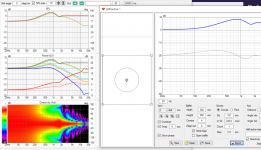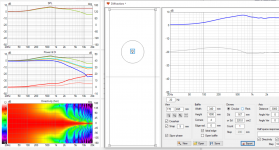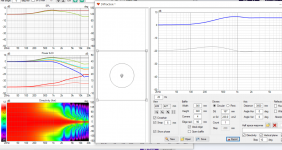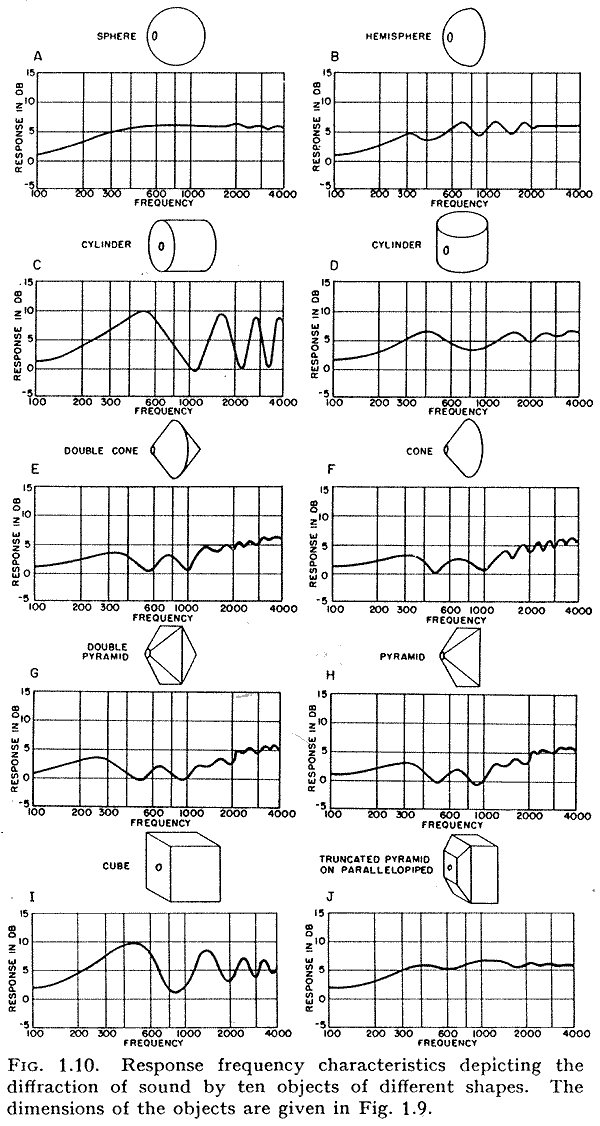This is just a poll to get a general view on preference regarding Baffle step compensation amount.
Please feel free to mention in the comments your speaker type, -3/-6/-10 dB point, room size and placement from rear and side wall.
Hope this poll will helpful to someone.
Please feel free to mention in the comments your speaker type, -3/-6/-10 dB point, room size and placement from rear and side wall.
Hope this poll will helpful to someone.
ok, this poll isn't getting much attention.
Is it because it doesn't help much without having an idea regarding the speaker placement and room size?
Creating a poll with options for varying placement and room size and BSC requires a lot more than 10 poll choices.
Is it because it doesn't help much without having an idea regarding the speaker placement and room size?
Creating a poll with options for varying placement and room size and BSC requires a lot more than 10 poll choices.
Baffle step compensation, do you inklude bafle placement compensation in your question? Somtimes in the same part of the circut like sensitivity and impedance correciton, combined in the same parts. Room size, placement,, reflection, your listening area...
I wish you luck with your statistic.
I wish you luck with your statistic.
I suppose it is difficult to isolate baffle step compensation from all other influences, such as driver response, diffraction effects etc.
using the usual x-over design tools you take a simulation (or even better: measurement) of the drivers in the enclosure+baffle and optimize response.
baffle step, diffraction, driver response would all be included in the simulation/measurements already.
using the usual x-over design tools you take a simulation (or even better: measurement) of the drivers in the enclosure+baffle and optimize response.
baffle step, diffraction, driver response would all be included in the simulation/measurements already.
Last edited:
I have implemented 3 dB but had to massively use room EQ at the same time. So I think I could be good with less. But I have never checked what is the difference in bass presentation between extended bass shelf, which is a in-build room, and linear FR, that requires ample amount of BSC combined with strong reduction of room bass modes.
European brick walls.
European brick walls.
Maybe I should have asked in full range forum too.samuelj you're right, however I'm not sure it wouldn't matter how sophisticated your poll was. Although it was reasonable for you to ask how much is "usually" used.
Have you considered asking this in the Full-Range forum?
But I believe it is somewhat difficult to draw a direct comparison between full range and multi-ways.
Full range usually have narrow dispersion at top end, cone breakup peaks and lesser low frequency bass, so BSC might be different or acoustical results might be different using same electrical BSC.
Your speakers might be very sensitive without BSC then.Indeed! My room is so lossy that I need none when the speakers are in the corners.
Are those control directivity speakers? Putting them in the corner doesn't hurt imaging?
Yes, but after getting ready all the measurements you still have to attenuate your higher frequencies wrt 150Hz which depends on room, placement and very much personal choice.I suppose it is difficult to isolate baffle step compensation from all other influences, such as driver response, diffraction effects etc.
using the usual x-over design tools you take a simulation (or even better: measurement) of the drivers in the enclosure+baffle and optimize response.
baffle step, diffraction, driver response would all be included in the simulation/measurements already.
I am not aware of any simulation software that automatically recommends a certain amount of BSC and whether it is suitable to the user.
Yes, they were a very sensitive/efficient [~112 dB/m stereo] horn system except for the subs which were corner loaded 6th order BPs and even these used dual ~96 dB/m, very low Fs, Qt 15", so rolled off up around 350 Hz unless corner loaded that flattened them out down to ~30 Hz before the corner gain faded away and no real room gain since the 1st eigenmode was ~12.5 Hz [calculated].Your speakers might be very sensitive without BSC then.
Are those control directivity speakers? Putting them in the corner doesn't hurt imaging?
Baffle step compensation is just some filter that makes the axial response flattish. It is called baffle step compensation because the lows can droop because of the baffle size not supporting ever longer wavelengths towards low frequencies, the speaker transitions from half space radiation to full space, low frequencies wrap around the enclosure to the back. If we have constant amount of acoustic output power exiting from transducer at any frequency then at some low frequency part of the power goes behind the speaker while at some high frequency the baffle reflects some of the power forward. Difference of these two conditions is seen in the axial response as missing lows, just because bigger part of the power bent around the speaker to the back.Yes, but after getting ready all the measurements you still have to attenuate your higher frequencies wrt 150Hz which depends on room, placement and very much personal choice.
I am not aware of any simulation software that automatically recommends a certain amount of BSC and whether it is suitable to the user.
With gated home measurements it can be hard to see the baffle step because of windowing so you might want to measure outside or rely on simulator, such as VituixCAD diffraction tool or any other diffraction simulator to get rough "baffle step". You could also use BEM simulation for more accurate results, which would include effects of the full enclosure and not just the baffle with ideal edge.
In general, sound has physical size to it as wavelength and it interacts with physical objects like transducers and baffles or any other structure. You could search for math how to calculate the bafflestep or just play with simulator to get some insight how it plays out. Below is attached as example ideal 8" driver on ideal 34cm * 34cm baffle and 34cm * 100cm baffle for comparison. 34cm would be wavelength of ~1kHz. If you halved the baffle dimensions the bafflestep would go octave higher.


Look at the top left graph, red line is axial response. Blue line on the middle graph is acoustic Power, look how it is almost flat through the "baffle step". Mind the db scale, forgot to zoom in on the tall baffle, sorry.
There is diffraction related "hump" about/below where baffle width is 1 wavelength, which is pronounced on the square panel due to symmetry and can contribute to the apparent amount of baffle step, but if you look after this hump the baffle step is 6db. If you look at the slope where the 6db line is crossed it would be roughly at baffle width ~1/2wl on the square baffle and little bit lower with the taller baffle so baffle step can be a bit sliding concept depending on where you have crossovers and what is the size of your construct. If you had multiway speaker so that crossover and driver sensitivies is planned to compensate this loss of baffle support at low frequencies you might not need baffle step compensation in the crossover. You might also plan for near wall position which would kind of extend the baffle on low frequencies, because of very long wavelengths, which would be another case that affects required compensation.
Hope it helps, thought to write this since you are currently interested on baffle step but same underlying concept of wavelengths interacting with physical object is something very core of any loudspeaker issues and properties. Basically all of your acoustic problems are due to vast difference of wavelength between 20Hz-20kHz, the other doesn't fit into average room and the other fits average belly button. Transducers acoustic dispersion to room interaction, modes, resonances, what have you, everything acoustic effects have wavelength as variable.
edit. to extend the example here is the square baffle with generous 9cm radius roundovers making it approach a sphere. Here we still have the bafflestep, but the edge diffraction related hump is almost gone and all that is left is ideal case 6db baffle step from ~1/2wl down.

edit: And to answer to the topic I guess people would measure the axial response or in-room response and listen and if there is need to compensate for bass then they will, it is so dependent on the speaker and where they are at in the room. Some would perhaps calculate on paper or use simulator to get into ballpark and then tune by ear or by measurement. If I remember from reading the forums people have referred to numbers like 3-4db. That said bass is quite hard to get right in room, partly due to hard to make measurements and room dominating the response. If your system might require baffle step compensation then prepare for it and tune in situ.
Last edited:
Yes, agree to whatever you just wrote. I always measure outdoors with finished cabinet. I use Jeff Bagby's excel based PCD/ response modeler/ Diffraction and Boundary simulator and VituixCAD. I believe everyone here is doing something similar.
But implemented BSC is also highly subjective. What you like for yourself might not work for me ( under same circumstances).
This is a poll regarding that preference.
And I admit, this poll is flawed since there are too many variable and only 10 choices.
Did you vote though?
But implemented BSC is also highly subjective. What you like for yourself might not work for me ( under same circumstances).
This is a poll regarding that preference.
And I admit, this poll is flawed since there are too many variable and only 10 choices.
Did you vote though?
Last edited by a moderator:
Didn't vote, I have on wall speaker project going on since few years and need to attenuate the bass at the moment. It is planned to take advantage of the wall, not to lose the bass. Previously i had fullrange speakers that would have required bafflestep compensation in theory but didn't implement it because it was fine after positioning the speakers in the room for balanced sound. This was before I had family so could do it 🙂
my experience with simulation software is somewhat limited, but e.g. boxsim (visaton software) will allow to define baffle, enclosure depth and driver position on the baffle. it will show the resulting on-axis and energy response graph. it does not include room influence.am not aware of any simulation software that automatically recommends a certain amount of BSC and whether it is suitable to the user.
the automatic response optimizer will try to get a smooth and linear on-axis response and includes influence of baffle and thus, formally speaking, will include 6 dB of baffle step compensation. but this is not handeled separated from the rest of driver response.
so, for the 2-way speaker I am about to complete i used 6 dB of BSC.
it is also very dependent on the room, listening distance, driver, baffle size, speaker positioning.But implemented BSC is also highly subjective.
Last edited:
BSC is a can of worms. As tmuikku says, it is a raising of the LF response on axis, so as to get closer to flat on-axis response. But it is noteworthy that for every dB you raise the on-axis closer to flat, you are raising the room response above flat by a dB. A no ein situation.
Possibly more important than an amount of change at the 2π tp 4π transition, is the shape of that transition.

What room, what speaker, what front-end, your taste, all play into the compromise of choosing what kind of BSC to add.
Of the literally 100s of loudspeakers we have built, only 1 had mor ethan 0dB of speciific on-axis FR lift. That answer is not in your poll.
dave
Possibly more important than an amount of change at the 2π tp 4π transition, is the shape of that transition.

What room, what speaker, what front-end, your taste, all play into the compromise of choosing what kind of BSC to add.
Of the literally 100s of loudspeakers we have built, only 1 had mor ethan 0dB of speciific on-axis FR lift. That answer is not in your poll.
dave
Its a good thing we don't have to care about all those different shapes of baffles, given most speaker baffles are narrow rectangles.
I am aware that you mostly build speakers with 'fullrange' drivers. Power response of these speakers are very different which might help you get away without using any BSC.
I am aware that you mostly build speakers with 'fullrange' drivers. Power response of these speakers are very different which might help you get away without using any BSC.
Very narrow dispersion at high frequencies.Why is power response different?
dave
- Home
- Loudspeakers
- Multi-Way
- Baffle step compensation sizing